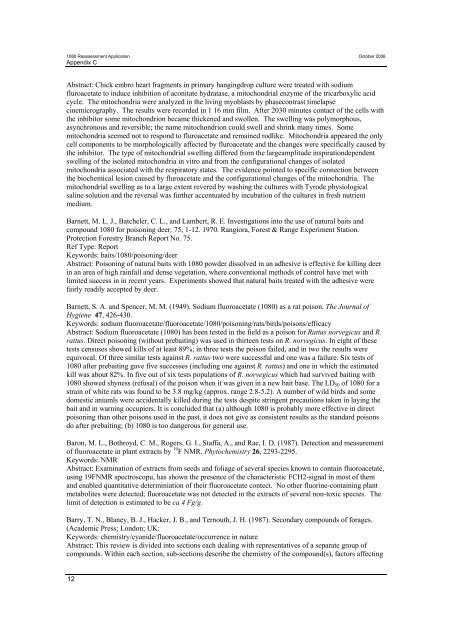Source: Landcare Research (1964). Control of poisons. Royal ...
Source: Landcare Research (1964). Control of poisons. Royal ...
Source: Landcare Research (1964). Control of poisons. Royal ...
You also want an ePaper? Increase the reach of your titles
YUMPU automatically turns print PDFs into web optimized ePapers that Google loves.
1080 Reassessment Application October 2006<br />
Appendix C<br />
Abstract: Chick embro heart fragments in primary hangingdrop culture were treated with sodium<br />
fluroacetate to induce inhibition <strong>of</strong> aconitate hydratase, a mitochondrial enzyme <strong>of</strong> the tricarboxylic acid<br />
cycle. The mitochondria were analyzed in the living myoblasts by phasecontrast timelapse<br />
cinemicrography. The results were recorded in 1 16 mm film. After 2030 minutes contact <strong>of</strong> the cells with<br />
the inhibitor some mitochondrion became thickened and swollen. The swelling was polymorphous,<br />
asynchronous and reversible; the name mitochondrion could swell and shrink many times. Some<br />
mitochondria seemed not to respond to fluroacetate and remained rodlike. Mitochondria appeared the only<br />
cell components to be morphologically affected by fluroacetate and the changes were specifically caused by<br />
the inhibitor. The type <strong>of</strong> mitochondrial swelling differed from the largeamplitude inspirationdependent<br />
swelling <strong>of</strong> the isolated mitochondria in vitro and from the configurational changes <strong>of</strong> isolated<br />
mitochondria associated with the respiratory states. The evidence pointed to specific connection between<br />
the biochemical lesion caused by fluroacetate and the configurational changes <strong>of</strong> the mitochondria. The<br />
mitochondrial swelling as to a large extent revered by washing the cultures with Tyrode physiological<br />
saline solution and the reversal was further accentuated by incubation <strong>of</strong> the cultures in fresh nutrient<br />
medium.<br />
Barnett, M. L. J., Batcheler, C. L., and Lambert, R. E. Investigations into the use <strong>of</strong> natural baits and<br />
compound 1080 for poisoning deer. 75, 1-12. 1970. Rangiora, Forest & Range Experiment Station.<br />
Protection Forestry Branch Report No. 75.<br />
Ref Type: Report<br />
Keywords: baits/1080/poisoning/deer<br />
Abstract: Poisoning <strong>of</strong> natural baits with 1080 powder dissolved in an adhesive is effective for killing deer<br />
in an area <strong>of</strong> high rainfall and dense vegetation, where conventional methods <strong>of</strong> control have met with<br />
limited success in in recent years. Experiments showed that natural baits treated with the adhesive were<br />
fairly readily accepted by deer.<br />
Barnett, S. A. and Spencer, M. M. (1949). Sodium fluoroacetate (1080) as a rat poison. The Journal <strong>of</strong><br />
Hygiene 47, 426-430.<br />
Keywords: sodium fluoroacetate/fluoroacetate/1080/poisoning/rats/birds/<strong>poisons</strong>/efficacy<br />
Abstract: Sodium fluoroacetate (1080) has been tested in the field as a poison for Rattus norvegicus and R.<br />
rattus. Direct poisoning (without prebaiting) was used in thirteen tests on R. norvegicus. In eight <strong>of</strong> these<br />
tests censuses showed kills <strong>of</strong> at least 89%; in three tests the poison failed, and in two the results were<br />
equivocal. Of three similar tests against R. rattus two were successful and one was a failure. Six tests <strong>of</strong><br />
1080 after prebaiting gave five successes (including one against R. rattus) and one in which the estimated<br />
kill was about 82%. In five out <strong>of</strong> six tests populations <strong>of</strong> R. norvegicus which had survived baiting with<br />
1080 showed shyness (refusal) <strong>of</strong> the poison when it was given in a new bait base. The LD50 <strong>of</strong> 1080 for a<br />
strain <strong>of</strong> white rats was found to be 3.8 mg/kg (approx. range 2.8-5.2). A number <strong>of</strong> wild birds and some<br />
domestic aniamls were accidentally killed during the tests despite stringent precautions taken in laying the<br />
bait and in warning occupiers. It is concluded that (a) although 1080 is probably more effective in direct<br />
poisoning than other <strong>poisons</strong> used in the past, it does not give as consistent results as the standard <strong>poisons</strong><br />
do after prebaiting; (b) 1080 is too dangerous for general use.<br />
Baron, M. L., Bothroyd, C. M., Rogers, G. I., Staffa, A., and Rae, I. D. (1987). Detection and measurement<br />
<strong>of</strong> fluoroacetate in plant extracts by 19 F NMR. Phytochemistry 26, 2293-2295.<br />
Keywords: NMR<br />
Abstract: Examination <strong>of</strong> extracts from seeds and foliage <strong>of</strong> several species known to contain fluoroacetate,<br />
using 19FNMR spectroscopu, has shown the presence <strong>of</strong> the characteristic FCH2-signal in most <strong>of</strong> them<br />
and enabled quantitative determiniation <strong>of</strong> their fluoroacetate contect. No other fluorine-containing plant<br />
metabolites were detected; fluoroacetate was not detected in the extracts <strong>of</strong> several non-toxic species. The<br />
limit <strong>of</strong> detection is estimated to be ca 4 Fg/g.<br />
Barry, T. N., Blaney, B. J., Hacker, J. B., and Ternouth, J. H. (1987). Secondary compounds <strong>of</strong> forages.<br />
(Academic Press; London; UK:<br />
Keywords: chemistry/cyanide/fluoroacetate/occurrence in nature<br />
Abstract: This review is divided into sections each dealing with representatives <strong>of</strong> a separate group <strong>of</strong><br />
compounds. Within each section, sub-sections describe the chemistry <strong>of</strong> the compound(s), factors affecting<br />
12








![Application for test certificate [pdf, 131kb]](https://img.yumpu.com/50666502/1/184x260/application-for-test-certificate-pdf-131kb.jpg?quality=85)








